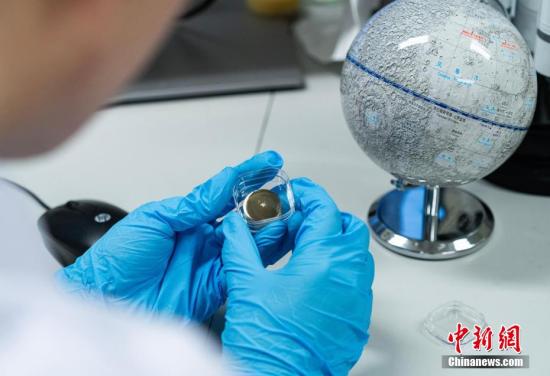China's Chang'e-6 lunar samples yield ground-breaking discoveries
It has been more than half a year since China's epic Chang'e-6 mission brough back to Earth the first-ever samples from the far side of the moon. What discoveries have been made so far? The China Central Television revealed on Tuesday a number of ground-breaking discoveries, including the volcanic activities on the far side of the moon, and the unveiling of ancient magnetic field of that side for the first time.
Chinese researchers also noted that in 2025, more lunar soil research projects are underway, including the physical property research of the Chang'e-6 samples and lunar evolution research. All these studies are accelerating forward, and with the implementation of subsequent missions like Chang'e-7 and -8, China is poised to usher in a new era of lunar exploration," reported CCTV.
At the Institute of Geology and Geophysics of the Chinese Academy of Sciences, hundreds of researchers have conducted multi-field analysis and research on 16 grams of the far-side lunar samples. Li Qiuli, a research fellow at the institute, and his team selected the first batch of 108 basalt debris particles. Their goal was to obtain the age information of each particle, as basalt carries key information about volcanic activity.
With the help of ion probes, the "element detective," Li and his team successfully completed the age analysis of the basalt debris in just three months. The discoveries from the analysis have been published in the international academic journal Nature. "Most of the 108 particles are 2.8 billion years old, but one was 4.2 billion years old - it is currently the oldest basalt in the Chang'e-6 return samples. Therefore, we conclude that the magmatic activity on the far side of the moon lasted for at least 1.4 billion years, and the properties of the deep mantle changed significantly during this period. This is the first time of such findings through the Chang'e-6 sample," said Li.
It is currently known that the volcanic activity on the near side of the moon can be traced back to 4 billion years ago, and there were still small-scale volcanic eruptions as late as 120 million years ago. What about the situation on the far side of the moon?
The research results of Chinese scientists based on the Chang'e-6 basalt particles are the first human understanding of the volcanic activity on the far side of the moon, offering critical insights and valuable scientific evidence for understanding the evolutionary history of the celestial body, reported CCTV.
In addition, Chinese scientists have revealed the ancient magnetic field characteristics of the moon's far side for the first time. According to Cai Shuhui, an associate researcher at the Institute of Geology and Geophysics, a study on four millimeter-sized basalt debris found that the moon had a magnetic field around 2.8 billion years ago, and this magnetic field showed a tendency to strengthen. "Previous research suggested that the lunar magnetic field experienced a sharp decline around 3.1 billion years ago, and after that, it might have remained in a very low-energy state. Our finding is quite different - We discovered that there was a rebound around 2.8 billion years ago, indicating that after the decline, there were fluctuations and recoveries," said Cai.
Previous studies have indicated that, similar to the Earth, the moon once had a global magnetic field, but this magnetic field no longer exists. There is still no scientific answer to the question of what change processes it went through before disappearing. This finding not only obtained the ancient magnetic field information of the moon's far side but also filled a billion-year data gap in the lunar paleomagnetic records, per experts cited by CCTV.
In 2025, more research projects are underway. Wu Fuyuan, an academician of the Chinese Academy of Sciences said his institution will conduct more research on the physical properties of these lunar samples.
Specifically, compared with Chang'e-5 samples, the Chang'e-6 ones exhibit greater stickiness, a property yet to be fully understood; what's more, Wu is eyeing to analyze the weathering characteristics of these samples in space, as well as possible water existence in the lunar soil to determine whether they can be used as material for the construction of future lunar base.
Liu Dunyi, a senior research fellow at Beijing SHRIMP Center, Institute of Geology, Chinese Academy of Geological Sciences, who have studied three lunar samples - one from the US Apollo mission and two from Chang'e-5 and -6, told the Global Times in an exclusive interview recently that a key focus of the research of the Chang'e-6 samples is whether the geological structures of the samples are from the near side or the far side of the moon will show differences, he said. "My team's research on Chang'e-6 samples has also been completed. It is currently under review and will be published in due course."
Liu said during his researches, his foreign friends who are also experts of the field expressed strong interest in collaborating with China. "Even facing the obstacle of US laws, they still strive to find ways to cooperate. China and the US have obvious complementary advantages regarding lunar scientific researches, and if combined together, humanity's knowledge toward the moon would develop much faster…" Liu noted. "It's a pity that the Wolf Amendment is like a wall standing between the two sides," he said.

